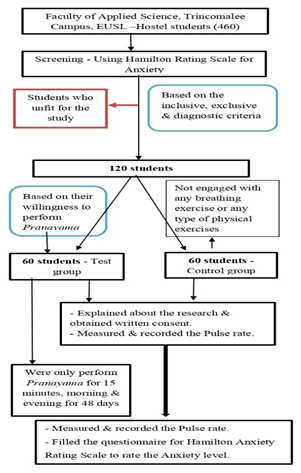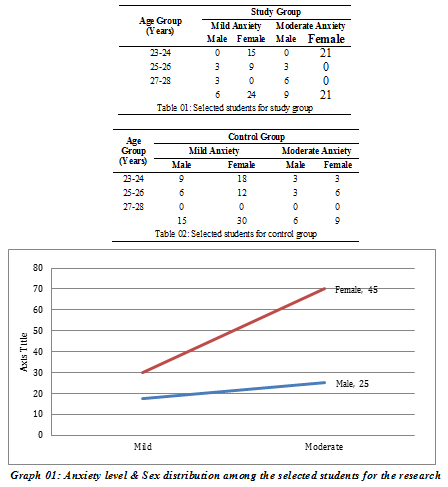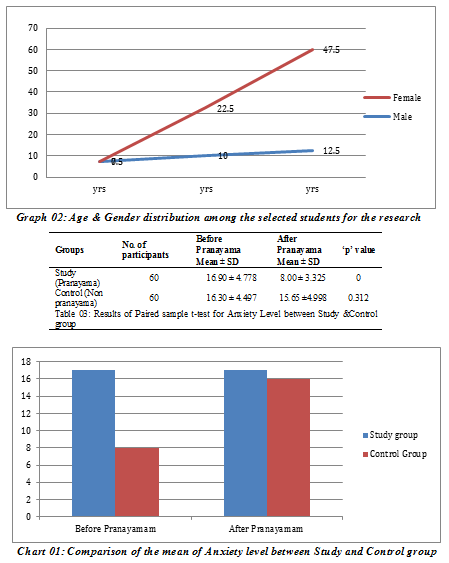Dr. Fathima Zeenath Nasurdeen[i], Dr. Anavarathan Vallipuram[ii]
DOI: 10.36283/pjr.zu.11.2/018
ABSTRACT
Introduction: Due to the competitiveness among the society which increases with the current lifestyle and education system, most of the students, especially the University students are under Stress & Anxiety1. Pranayama meant an Alternative nostril breathing exercise and it is a cost-free, amazing therapy.
Objective: This study was conducted to evaluate the effect of Pranayama on Stress and Anxiety and the Pulse rate among the selected students from the Faculty of Applied Science, Trincomalee Campus, Eastern University Sri Lanka.
Methodology: This is a randomized control experimental study. Screening was done by using the tool of the Hamilton Rating Scale for Anxiety (HMA-A or HARS- 1959)2. Among the 460 hostel students, 120 participants were selected based on the inclusive, exclusive & diagnostic criteria. They were divided into two groups by a random selection process; 60 participants from the study group were only performed Pranayama daily for 15 minutes in the morning and the evening for 48 days. The remaining 60 in the control group were not engaged with any breathing exercise or any type of physical exercise. The data was analyzed using SPSS.
Results: A reduction in Stress & Anxiety level scores from 16 ± 4.7 to 8 ± 3.3 after practicing Pranayama. An extremely significant ‘p’ value of less than 0.001 was obtained. And also it showed a mild reduction in pulse rate from 74.9 ± 6.4 to 73.2 ± 2.7 bpm too.
Conclusion: Regular practice of Pranayama for a certain period is beneficial to reduce the Stress and Anxiety level and regulating the pulse rate.
Keywords: Pranayama, breathing-exercise, stress, anxiety, HARS, pulse rate.
Introduction
According to the American Psychological Association in 2019, Stress is a functional and emotional reaction to circumstances or events that disturb the balance of a creature3. Father of modern psychology & psychiatry, Sigmund Freud said that Anxiety rises from a transformation of the accumulated tension or stress4. Stress and Anxiety are difficult to distinguish from one another due to their similar clinical features. Anxiety can be a reaction to Stress, or people who are unable to identify significant stressors in their life can affect with anxiety5.
In a study in 2018, around 792 million people were with psychological disorders. This is slightly more than one-tenth of the people globally (10.7%). And the global population with Anxiety disorders is 3.8% (2.5-7%) and among them, 2.8% in males and 4.7% are females6. In Sri Lanka, a significant proportion of adolescents suffer from symptoms of Anxiety and Depression7.
Siddha Medicine is a prehistoric system of medicine prevalent in South India and North & Eastern parts of Sri Lanka. In Siddha system of medicine, Food habit, Lifestyle, Yoga, and Meditation play a significant part in maintaining health and curing diseases by restoring balance to the mind and body8. Yoga is an art which means to join or combine. It brings harmony through practices such as; Asana, Pranayama, and Meditation9. Pranayama is one of the eight limbs of Yoga and it’s a breathing exercise. “Prana” is the vital force or energy that sustains all of creation. Breathing exercises steadies the mind and cleanses the body through controlling one’s Prana10. It is inhaling, exhaling, and withhold the vital air and it controls the mind without alteration, improves the intellect, and makes the body eternal11.
When an individual feel nervous, worry, fear of bad or unpleasant will happen and feeling of tension are related with an stimulation of the autonomic nervous system12. Academic burden, challenging workloads, worry about own health, and financial worries are the factors involved in psychological morbidity among students1, 13. Excessive and frequent Anxiety can weaken functioning, because negative effects on the academic performance of the students8. In either way it is defined, the principal characteristic of Anxiety is worrying, and it is clear that Anxiety has a negative effect on all aspects, such as, social, personal, and academic performance10.
Earlier in 1970s, depression and anxiety like psychological issues were treated with simple methods which are easy to practice. Those are Yoga, meditation and other stress-reduction techniques. Yoga has received less responsiveness in medical fields however it has become gradually popular in recent years. The impact of overstated stress responses can reduce by Yoga practices and can be helpful for both Anxiety and Depression14.
Regular practice of Pranayama has an amazing effect in treating stress-related disorders by decreasing stress hormone level cortisol and improves body and mental integration, slow down the continuous rush of thoughts, develops a steady mind, strong willpower, improve the sense of well-being and enhance perception. And also it decreases the blood pressure and heart rate by lowering the level of blood triglyceride, slightly reduces the oxidative stress, significantly increases antioxidant capacity and improves sleep due to the changes in the autonomic nervous control toward the parasympathetic side. Students felt calm, joyful, and in good spirits15,16,17,18.
Since many researches have been conducted about Stress and Anxiety, this study was aimed to identify the effect of Pranayama on Stress and Anxiety and the Pulse rate among the selected students in Faculty of Applied Science. It is high time to conduct this study as nowadays people are concern about maintaining mental health too. Pranayama is a cost-free amazing breathing technique and every one can practice. This study was conducted among the university students for the purpose of reach among public which can be achieved quickly through students’ community.
Methodology
A randomized control experimental study was carried out at the Faculty of Applied Science, Trincomalee Campus, Eastern University Sri Lanka from September to November 2020 (48 days). Anxiety status was assessed by Hamilton Anxiety Rating scale (HARS). It is a symptom rating scale includes a questionnaire, probes 14 parameters.
Inclusive and diagnostic criteria are mild to moderate Anxiety scored hostel students were selected based on HARS. The students scored less than 17 are considered as mild and 18 to 24 were considered as moderate Anxiety students and both these groups were taken for this study. Above 8 is considered as the lowest value for mild anxiety. Exclusive criteria are, the students who scored severe anxiety based on HARS (scored 25 to 30), Non-hostels, Smokers & Alcoholics, Students with any chronic or systemic diseases & following any medications, Students with chest deformities like Kyphosis & Scoliosis, Students who are not willing to come for regular follow up and Students who are already using any test drugs.
Procedure to preform Pranayama is Sit up straight in Padhmasana or Vajirasana position. Place the left hand on the left thigh in Dyana mudra. Hold the right hand up to the face in Vishnu mudra. Use the right thumb and ring finger to block the nostril. Inhaling into 4 counts, retaining is 16 counts and exhaling to 8 counts in the final stage of the practice. First begin with just inhaling to 4 counts & exhaling to 8 counts (for initial practice). Block the right nostril with the right thumb and slowly inhale through the left nostril (4 counts). Then close the left nostril with the ring finger and keep retaining for 16 counts (do this retaining until you can). Release the breath slowly through the right nostril by release the pressure of the thumb on the right nostril. Next, inhale through right nostril, retaining and exhale as the same count in same manner. This is one round. Repeat for 15 minutes.
Statistical Package for Social Science (SPSS) version 16 was used to analyze the data. Paired sample t-test was applied before and after the Pranayama practice.

Ethical concern
Informed written consent was taken from the participants in the subject’s mother tongue.
Results



Discussion
According to the statement in a study, that females are more likely affected with Anxiety than males with period of time and past year rates females are 1.5 – 2 times higher than males19. As shown in Graph 01, there were 45% of female & 17.5% of male students in mild Anxiety, 25% of female & 12.5% of male students in moderate Anxiety. The above result has shown very significant differences that are 70% of female & 30% of male students in Anxiety among the selected students in both study and control group.
A significant percentage of young people suffer from symptoms of Stress, Anxiety and Depression in Sri Lanka7. As shown in graph 02, the above finding revealed that 47.5% of female & 10% of male students in the age group of 23-24 years, 22.5% of female & 12% of male students in the age of 25-26 years and 7.5% of male students only in the age group of 27-28 years old among the selected students in both groups.
As shown in Table 03, the results of the paired sample t-test, on the study group show that means Anxiety level differs before doing Pranayama (M= 16.9, SD= 4.77) and after doing Pranayama (M= 8.00, SD= 3.325). On average Anxiety, the level is about 8.9 points lower after doing Pranayama. And the ‘p’ value is (0.000) < 0.05. Students who practiced Pranayama regularly have a significant effect of reducing Anxiety status and improving the sense of well-being10, 15, 16, and 20,21,22,23.
The above results revealed that Pranayama really does have an effect on Stress and Anxiety level and it confirms the claims through the ‘p’ value (0.000) less than 0.05, of the previous studies that regular practice of Pranayama is beneficial to reduce the Stress and Anxiety level among the students.
As shown in Table 04, the Pulse rate was reduced by the regular practice of Pranayama for a certain period18,24,25 and the above result showed that there was a mild reduction (mean pulse rate before doing Pranayama is 74.9 and after doing Pranayama is 73.2) in the study group and it towards the average Pulse rate of a healthy adult. Therefore, it can claim that regular practice of Pranayama regulates the Pulse rate in the study group.
The above research results (Chart 01) also revealed that there was a mild reduction in the Anxiety level and Pulse rate in the control group too. But it was not significant. The fact behind these changes in the result may be due to the changes in the environment such as academic pressure and workloads13. The study should carry out in the same environment (study area), as the changes in the environment also affect the test result.
However, there is a limitation of the present study like the anthropometric measurements not considered.
Conclusion
The modernized current life style and education system causes stress and anxiety among students. This study shows that the regular practice of Pranayama for a certain period of time is effective in reducing the Anxiety level (‘p’ value is 0.000 < 0.05) and regulating the Pulse rate among the students. It would be more effective if the number of participants and duration of the study will be increased in future studies.
References
- Bataineh Marwan. Academic Stress among Undergraduate Students: The Case of Education Faculty at King Saud University. International Interdisciplinary Journal of Education. 2013; 2. 10. 12816/ 0002919
- Hamilton M. The assessment of anxiety states by rating. BrJ Med Psychol 1959; 32:50–55.
- American Psychological Association. Stress in America: Stress and Current Events.2019:https://www.apa.org- assessed on 18.12.2020.
- Freud Museum London. What did Freud say about Anxiety? 2018 freud.org.uk – assessed on 24.05.2020.
- Katie Hurley, LCSW. Stress and Anxiety – Article by IMHCA: https://www.imhca.org- assessed on 20.12.2020.
- Hannah Ritchie and Max Roser.”Mental Health”. Published online at OurWorldInData.org. 2018. Retrieved from: ‘https://ourworldindata.org/mental-health’
- Rodrigo, C., Welgama, S., Gurusinghe, J.et al. Symptoms of anxiety and depression in adolescent students; a perspective from Sri Lanka. Child Adolesc Psychiatry Ment Health 4, 10 (2010).
- Kaliyaperumal, et al., Tamil traditional Medical System – Siddha: An indigenous Health Practice in the International Perspectives. International journal of Genuine Traditional Medicine (TANG), 2010; 2(2), p. 2.
- Senthil Kumar et al., Consolidate effect of Vibhagha pranayamam, Nadishuddi pranayamam, Saviththiri pranayamam & Kapalabhati pranayamam on the Pulmonary functional status young healthy male subjects, International Journal of Medical Research & Health Sciences, March 2013; 2(3):350-356.
- Azadeh Nemati, et al., The effect of pranayama on test anxiety and test performance International journal of Yoga, 2013 Jan- Jun; 6(1): 55-60.Vignesh K et al., An overview of Breathing Exercise in Siddha concept- A Literature Review, Siddha papers; 2018 (13)(2)
- Spielberger CD.Manual for the state- trait anxiety inventory. Palo Alto, CA: Consulting Psychologist Press; 1983.
- January, J., Madhombiro, M., Chipamaunga, S.et al. Prevalence of depression and anxiety among undergraduate university students in low- and middle-income countries: a systematic review protocol. Syst Rev 7, 57 (2018).
- Pallav Sengupta, Health Impact Of Yoga and Pranayama: A state of the Art Review, International Journal Of Preventive Medicine: 2012 Jul; 3(7): 444-458
- Gupta PK, Kumar M, Kumari R, Deo JM. Anuloma-Viloma pranayama and anxiety and depression among the aged. Journal of the Indian Academy of Applied Psychology. 2010 Jan; 36(1):159-64
- Usha Patil et al. Effect of paranayamam and aerobic exercise on anxiety status of medical students. International Journal of Recent Trends in Science and Technology, June 2014; 11(2): 214-217).
- Krishan Bihari Verma, Seema, Subarna Ghosh, Chandana Bera. “Effect of Pranayama on Blood Pressure and Heart Rate in Hyper reactor to Cold Presser Test”. Journal of Evolution of Medical and Dental Sciences 2014; Vol. 3, Issue 30, July 28; Page: 8511-8521.
- Moni Kumari, et al, Effect of Pranayama on Geriatric Depression: A study of Madhubani District of North Bihar, Scholars Journal of Arts, Humanities and Social Sciences; Sep
- Dorte M. Christiansen, Examining Sex and Gender Differences in Anxiety Disorders, A fresh Look at Anxiety Disorders, Federico Durbano, IntecOpen, DOI, 2015: 10.5772/60662.
- Shastri VV, Hankey A, Sharma B, Patra S. Investigation of yoga pranayama and vedic mathematics on mindfulness, aggression and emotion regulation. International Journal of Yoga 2017; 10: 138- 44.
- Novaes MM, Palhano-Fontes F, Onias H, Andrade KC, Lobão-Soares B, Arruda-Sanchez T, Kozasa EH, Santaella DF and de Araujo DB. Effects of Yoga Respiratory Practice (Bhastrika pranayama) on Anxiety, Affect, and Brain Functional Connectivity and Activity: A Randomized Controlled Trial. Psychiatry11:467. doi: 10.3389/fpsyt.2020.0046.
- Gupta, Nidhi & Khera, Shveta & Vempati, Ramprasad & Sharma, Ratna & Bijlani, R. Effect of yoga based lifestyle intervention on state and trait anxiety. Indian Journal of Physiology and Pharmacology, 2005; 50, 41-47.
- Sonali Bhoyar, ArshiyaKhan, Saroj Tirpude, Namrata cahuragade, Kaustubh Bhoyar, Anuj Varma. Effect of Pranayama in Relieving Stress: A Review Article. European Journal of Molecular & Clinical Medicine. Vol. 08, Issues 01, 2021; 2515-8260
- Ankad, R. B., Herur, A., Patil, S., Shashikala, G. V., & Chinagudi, S. Effect of short-term pranayama and meditation on cardiovascular functions in healthy individuals. Heart views: the official journal of the Gulf Heart Association, 2011; 12(2), 58–62.
- Pramanik, Tari & Pudasaini, B & Kumar, Ashish. Immediate effect of a slow pace breathing exercise Bhramari pranayama on blood pressure and heart rate. Nepal Medical College journal: 2010; NMCJ. 12. 154-7.
The Ziauddin University is on the list of I4OA (https://i4oa.org/) & I4OC (https://i4oc.org/).
![]() This is an open-access article distributed under the terms of the Creative Commons Attribution License (CC BY 4.0). https://creativecommons.org/licenses/by/4.0/
This is an open-access article distributed under the terms of the Creative Commons Attribution License (CC BY 4.0). https://creativecommons.org/licenses/by/4.0/
Conflict of Interest: The author (s) have no conflict.
[i] Intern Medical officer Department of Ayurveda, Ministry of Indigenous Medicine, Sri Lanka
ORCID ID: 0000-0003-4660-6780
[ii] Senior Lecturer, Faculty of Applied Science, Trincomalee Campus, Eastern University Sri Lanka
ORCID ID: 0000-0002-5987-2757
